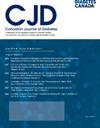What Is the Effectiveness of Type 2 Diabetes–related Patient Decision Aids? Secondary Analysis of a Systematic Review
IF 2.3
4区 医学
Q3 ENDOCRINOLOGY & METABOLISM
引用次数: 0
Abstract
Objectives
Patient decision aids (PtDAs) are evidence-based interventions to help people faced with difficult health-care decisions. Little is known about their effectiveness in people facing diabetes-related decisions. The aim of this study was to evaluate the scope and effectiveness of diabetes-related PtDAs for screening, prevention, and treatment decisions.
Methods
A secondary analysis of randomized controlled studies (RCTs) from the 2024 Cochrane review of PtDAs comparing decision aids on diabetes screening, prevention, or treatment to usual care (e.g. patient education, no intervention) was conducted. Two reviewers independently screened citations, extracted data, and assessed study quality. Primary outcomes included quality of the decision and decision-making process. Meta-analyses were conducted for similar outcome measures.
Results
Of the 209 RCTs, 11 eligible studies evaluated diabetes PtDAs for treatment (n=7), screening (n=3), and prevention (n=1). Common decisions were about diabetes treatment intensification (n=4) and statin initiation (n=3) in people with type 2 diabetes. Compared with usual care, the PtDA group reported increased knowledge (mean difference [MD] 16.06, 95% confidence interval [CI] 8.38 to 23.75) and clearer values (MD −7.43, 95% CI −13.23 to −1.63) and no difference in accurate risk perceptions. After removing high-risk-of-bias studies, PtDAs led to fewer patients feeling uninformed about their options (MD −6.38, 95% CI −9.58 to −3.19) and more participants starting new medications (relative risk ratio 1.65, 95% CI 1.06 to 2.56). Six studies measured adherence to a chosen option: 1 reported greater adherence, whereas another reported lower adherence in PtDA vs usual care and the remaining 4 reported no difference.
Conclusions
Patients given PtDAs can improve their knowledge and feel informed and clearer about their values while being more likely to start new medications. Future research can strengthen the certainty of these findings and should explore PtDA use within the chronic disease context.
2型糖尿病相关患者决策辅助的有效性是什么?系统评价的二次分析。
患者决策辅助(ptda)是基于证据的干预措施,以帮助人们面对困难的医疗保健决定。对于面临糖尿病相关决定的人来说,它们的有效性知之甚少。方法:对2024年Cochrane回顾ptda的随机对照试验进行二次分析,比较糖尿病筛查、预防或治疗的决策辅助与常规护理(如患者教育、不干预)。两位审稿人独立筛选引文、提取数据并评估研究质量。主要结果:决策质量和决策过程。对类似的结果测量进行了荟萃分析。结果:在209项随机对照试验中,11项符合条件的研究评估了糖尿病ptda的治疗(n=7)、筛查(n=3)和预防(n=1)。在2型糖尿病患者中,常见的决定是加强糖尿病治疗(n=4)和开始他汀类药物治疗(n=3)。与常规护理组相比,PtDA组患者对风险的认知增加(MD为16.06,95%CI为8.38 ~ 23.75),价值更清晰(MD为-7.43,95%CI为-13.23 ~ -1.63),但对风险的准确认知无差异。在去除高风险偏倚研究后,ptda导致较少的患者不了解他们的选择(MD -6.38;95%CI -9.58至-3.19),更多的参与者开始使用新药物(RR 1.65, 95%CI 1.06至2.56)。六项研究测量了所选方案的依从性:一项报告了PtDA与常规治疗相比更高的依从性,另一项报告了更低的依从性,其余四项报告没有差异。结论:接受ptda治疗的患者可以提高他们的知识水平,更清楚地了解自己的价值观,同时更有可能开始新的药物治疗。未来的研究可以加强这些发现的确定性,并探索ptda在慢性疾病中的应用。
本文章由计算机程序翻译,如有差异,请以英文原文为准。
求助全文
约1分钟内获得全文
求助全文
来源期刊

Canadian Journal of Diabetes
ENDOCRINOLOGY & METABOLISM-
CiteScore
4.80
自引率
4.00%
发文量
130
审稿时长
54 days
期刊介绍:
The Canadian Journal of Diabetes is Canada''s only diabetes-oriented, peer-reviewed, interdisciplinary journal for diabetes health-care professionals.
Published bimonthly, the Canadian Journal of Diabetes contains original articles; reviews; case reports; shorter articles such as Perspectives in Practice, Practical Diabetes and Innovations in Diabetes Care; Diabetes Dilemmas and Letters to the Editor.
 求助内容:
求助内容: 应助结果提醒方式:
应助结果提醒方式:


